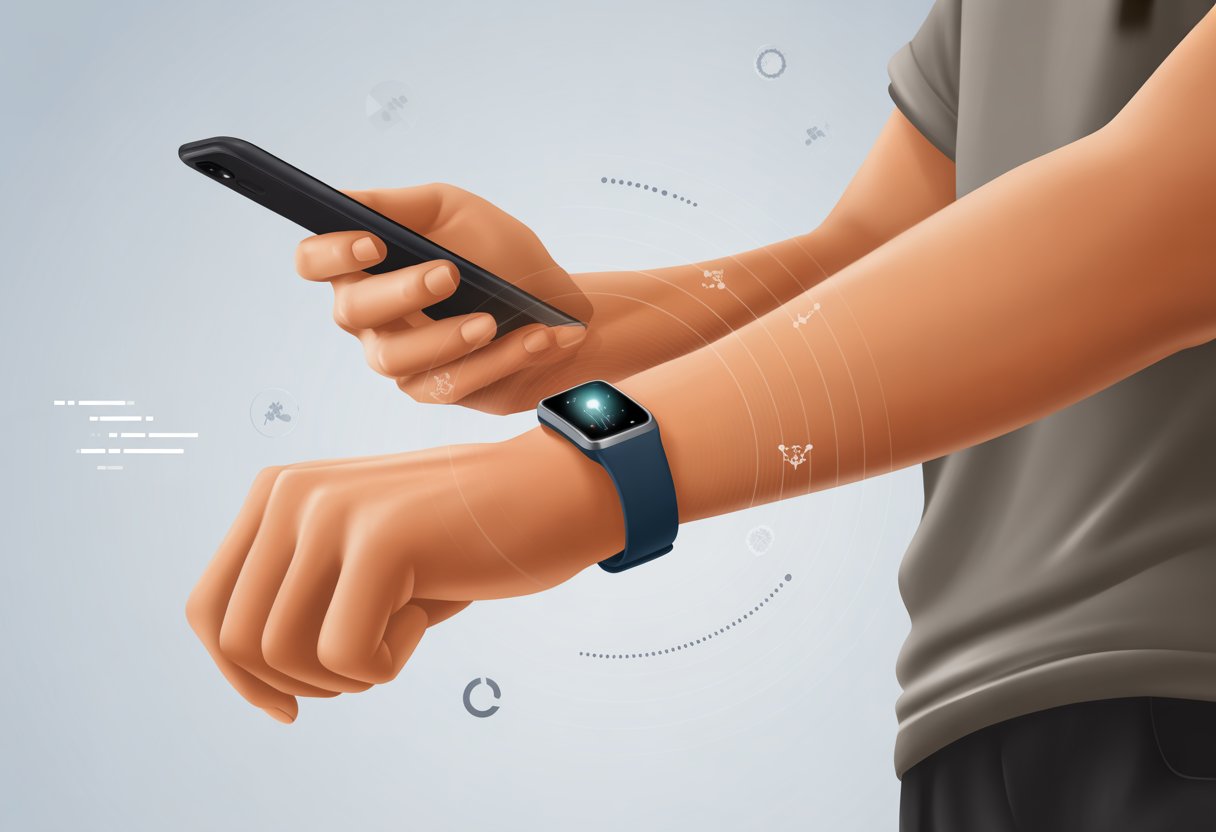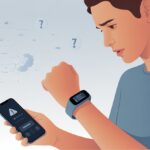We’ve all been there—standing in the living room, waving our wrists around, wondering why our shiny fitness tracker just won’t sync. Suddenly, all those steps from chasing the dog seem to have disappeared.
Usually, our fitness tracker syncs slowly because of weak Bluetooth, outdated apps, or just stubborn tech.

If you’re tired of waiting for that progress bar that crawls slower than we do on a Monday, you’re not alone. It’s annoying when those hard-earned steps show up late or, even worse, not at all.
Don’t worry—we’re about to dig into the usual reasons for slow syncing and share a few fixes that might actually help. We deserve to see our sweaty efforts counted right away, not after a full weather cycle and three cups of coffee.
Let’s try to figure out why syncing sometimes feels harder than our last workout.
Why Fitness Trackers Sync Slowly
We’ve all stood next to our phones, waving our arms like magicians, hoping our fitness data will sync. Sometimes it works instantly, and other times it feels like our step count is traveling by carrier pigeon.
Understanding Syncing Processes
When we sync our fitness trackers, we’re just asking the device to move data—steps, heart rate, sleep—from the tracker to our phones. This can involve Bluetooth, Wi-Fi, and sometimes the cloud.
Each brand, like Fitbit or Apple Watch, uses its own method to send all our workout data across the digital highway. The road is often bumpy. Our trackers might try to sync a lot of info at once, which takes time.
Sometimes, the tracker wants to connect but our phone is busy texting grandma. Syncing also slows down if there are updates or if an app is napping in the background. When any part of this process drags, so does our step count update.
Common Causes of Slow Synchronization
A lot of things love to slow syncing to a crawl. Bluetooth connections can get unreliable, especially when pairing a Fitbit with an Android phone or an Apple Watch with an old iPhone.
Obstacles like other electronics or even a stubborn microwave can mess with the signal. Apps on our phones add to the chaos—if we have too many open, our tracker might have to wait in line.
Old software is another classic culprit; missing an update can lead to the syncing blues. Even health data itself—lots of sleep records, heart rate charts, and steps—can clog things up.
People online have reported slow sync times, especially with certain devices and apps, such as when trying to sync Apple Health data. Wi-Fi issues, weak internet, or using battery-saving mode can make things worse.
If our tech isn’t playing nice, syncing just drags.
Impact of Device Compatibility
Our fitness trackers and phones sometimes act like old friends who just can’t get along. A newer Fitbit might struggle with an older Android. Mixing an Apple Watch and an iPad can feel like introducing cats and dogs.
App updates sometimes leave our devices out of sync if one gets updated but the other doesn’t. We’ve seen complaints online about how Fitbit syncs can be slow and unreliable, especially when devices aren’t fully supported.
Certain phones have trouble with Bluetooth, causing random disconnects. Using a device not officially supported by the brand, like syncing a tracker with an old iPad, just adds to the hassle.
Compatibility issues can create frequent syncing problems or mysterious gaps in our activity logs. Making sure our devices actually like each other can save us a lot of syncing frustration.
Bluetooth and Connectivity Issues
Sometimes, our fitness trackers act like stubborn pets—refusing to cooperate when we need them most. Slow syncing usually comes down to Bluetooth troubles, app confusion, or just too many devices fighting for attention.
How Bluetooth Impacts Sync Speed
Bluetooth is our tracker’s main way to gossip with our phones. If we pair too many devices, our tracker might get distracted and refuse to share its steps.
Bluetooth connections get weird if we move too far from our phone—kind of like shouting across a noisy room. A weak signal, old firmware, or a busy Bluetooth channel slows things down.
Even thick walls or microwaves (no, really) can block or weaken the signal. If we’re using the Fitbit app or Apple Health, our trackers need a clear path to deliver all those hard-earned steps.
Sometimes, Bluetooth just wants a fresh start. Turning it off and on again is the grownup version of “did you try unplugging it?” and it works more often than we’d care to admit.
Troubleshooting Connection Problems
Let’s roll up our sleeves. First, we should check if Bluetooth is even on. (No shame—we’ve all missed that step.)
Next, close and reopen the Fitbit app or whatever health app we’re using. Sometimes, apps freeze and just need a nudge.
If syncing is still slow, restarting our phone or toggling Bluetooth off and back on can force the tracker to wake up. It also helps to unpair and re-pair our tracker if it’s being extra stubborn.
Having a low battery on either our phone or tracker can mess with syncing too, so a quick charge before troubleshooting is smart.
For Apple Health users, double-check permissions in app settings. Missing access can quietly block syncing progress.
And if all else fails, blame Bluetooth gremlins (or check out more advice from the Fitbit Community).
Tips for Stable Pairing
Keeping the connection strong doesn’t take a genius, but a few smart moves help. Here’s a quick list to spare us more syncing stress:
- Only keep the devices paired that we actually use. Too many connections just confuse things, as Google Help points out.
- Turn off extra Bluetooth gadgets when syncing our tracker.
- Place our phone and tracker close together while syncing. Proximity helps Bluetooth work its magic.
- Avoid syncing in places with thick walls or electronics like microwaves or wireless routers.
- Charge our devices—low battery makes everything slower (even us).
A few quick tricks go a long way. If all else fails, give the devices a break and come back in a few minutes.
If things are still stuck, there’s always the classic “contact support and hope for mercy” approach.
Software Settings and Operating Systems
Sometimes, our fitness tracker just wants to take its sweet time syncing. The main culprits usually hide in our device settings or the operating system itself.
We can’t always blame it on “vibes”—fussy settings and old updates are almost always to blame.
Influence of Device Settings
When syncing slows down, it often comes down to our own device settings. Bluetooth might be off, running slow, or drowning in connections.
Pairing our tracker to more than one device (like both an iPhone and an iPad) at once just confuses it. It’s like giving it two party invites—now it can’t decide where to show up.
Background app settings make a difference too. If we restrict background activity, the fitness app might not sync unless it’s open, which means our steps get stuck.
Turning off battery-saving modes, double-checking location permissions, and allowing notifications can help speed things up. For tricky situations, removing the tracker from Bluetooth, restarting both gadgets, then reconnecting often helps, just like what users found in the Fitbit Community.
Effect of Operating System Updates
Operating system updates—whether it’s iOS, iOS 12, older Android phones, or that ancient iPad in the drawer—sneakily affect syncing speed. When our phone runs on outdated software, compatibility problems pop up.
Sometimes, our tracker’s newest update just doesn’t want to hang out with an old operating system, which leaves us with a confused tracker and a lot of unsynced workouts.
Apps connecting with Apple Health can freeze or lag after an OS update, as some have shared in Apple’s support forums. Updating the operating system usually fixes these issues.
But if we jump onto a new update too quickly, we might run into bugs that make syncing even worse—a real “out of the frying pan” moment. The trick is to update often, but give it a few days for any app fixes to roll out.
App-Specific Syncing Challenges
We love our step-counting gadgets, but syncing them to our favorite apps can feel like herding cats. Every app seems to have its own quirks when it comes to syncing our workout data.
Issues with the Fitbit App
We’ve all spent too much time staring at that spinning “syncing” circle in the Fitbit app. Usually, a slow Bluetooth connection or our phone pretending it doesn’t see the tracker is to blame.
Sometimes, turning Bluetooth off and back on, or the classic “turn it off and on again” with both our phones and Fitbits, does the trick. As old-fashioned as it sounds, this fix works more often than we’d like to admit.
If that doesn’t help, removing the tracker from the app’s device list and re-adding it often solves it. Sync speeds crawl when we’re running too many apps at once or our phone feels overwhelmed.
Having a stable Wi-Fi connection and making sure both the app and firmware are up to date helps, as discussed on the Fitbit Community.
Apple Health and Health App Quirks
The Apple Health app has a reputation for acting more like a security guard than a data collector. Syncing sometimes stalls because we haven’t granted all the right permissions for our health and workout data to travel between apps.
We can run into trouble after buying a new phone or updating our devices. Restarts often act like a “get out of sync jail free” card, so rebooting both our iPhone and Apple Watch is worth a shot.
Some users notice that, even after doing everything right, workout data can take up to ten minutes to show up—patience, apparently, is a fitness virtue. If everything else fails, a deep dive into phone settings and making sure the Health app is allowed to access everything it needs is key.
For step-by-step help, community members on Apple’s support forum and users on Reddit have shared some solid insights to make wrangling the Health app a little less tricky.
Time-Related Trouble: Time Zones, Daylight Saving, and Satellite Signals
Honestly, keeping our fitness trackers in sync with real-world time sometimes feels like a puzzle we never asked for. We deal with weird time displays, random time zone jumps, and stubborn GPS signals—it’s a wonder we even know when our runs start.
Sync Delays Caused by Incorrect Time
If we spot our tracker lagging behind or showing the wrong hour, it’s usually because of an incorrect time setting. Our fitness trackers grab the time from our phones or a server to stay accurate.
When something goes wrong—maybe our phone’s time is set manually, or daylight saving didn’t update—data can sync at the wrong moments. Suddenly, our step or heart rate logs look like they were recorded in another universe.
To fix it, we should check that our device and phone use automatic time updates. Sometimes, toggling this setting off and on again forces a fresh update.
For stubborn trackers, a quick resync or a restart often works. It’s a small hassle, but it can make syncing so much smoother.
The Great Time Zone Mystery
Traveling with a tracker can get weird when it insists we’re still jogging back home. Some fitness trackers can’t keep up when we cross time zones.
If our watch or app doesn’t update by location, it lags behind. When we move between zones, our device needs a nudge.
Some trackers update instantly when connected to our phone. Others want us to open the app and let it use our GPS or network location.
If we skip this step, our workouts might end up labeled in the wrong city—or even the wrong day. Syncing with our phone and updating the app when we land usually solves this.
Garmin users can just sync with the Garmin Connect app and call it a day.
GPS and Satellite Signal Shenanigans
Trackers that use GPS or satellites can turn syncing into a bit of a circus when the connection drops. If our tracker scrambles for a weak GPS signal, activity data might get delayed or go haywire.
We’ve all stood outside, waving our arms, waiting for the GPS icon to stop spinning. Buildings, bad weather, and forests can block or weaken GPS.
Without a strong signal, our tracker might think we started our workout on Mars. To help, we can wait a moment in an open area before starting the activity.
Satellite data updates can take longer after a time zone change or daylight saving switch. Sometimes, all it takes is patience, some fresh air, and open skies to get our tracker back on track.
Data Overload and Sync Speed
When our fitness trackers sync slowly, it’s not just bad luck. Usually, an avalanche of health data, workout files, and calorie details is squeezing through Bluetooth or Wi-Fi, one byte at a time.
Let’s dig into why our trackers lose their cool when overloaded.
Too Much Health Data Slows Things Down
We collect more health data than we realize—steps, heart rate, sleep, and even that one workout we regret. Our trackers save it all.
Over time, this data piles up. Syncing starts to crawl.
If we never delete old records or clear history, syncing gets so sluggish we might wonder if the tracker needs a nap. Apps can freeze or stop responding, especially when syncing with services like Apple Health.
Some folks find the app just stops working or takes forever to update new activity. Trimming old data or resetting parts of our health logs can help speed things up.
Large Workout and Fitness Calibration Files
Syncing big workout files or loads of calibration data is like shoving bricks through a straw. Each workout with stats, GPS, and calibration info adds extra megabytes.
Special calibration files help improve tracking accuracy, but they’re bulky. Over time, these stack up.
If we never reset our fitness calibration data, syncing can stall while our device pushes all those files onto our phones. Deleting old activities and resetting calibration data now and then gives our tracker a fresh start.
Calories and Data Processing
Counting calories is tough for us, and our trackers struggle too. Every movement, snack, and burned calorie adds to the pile, and the device has to process and sync it all.
When calorie data and detailed logs stack up, the tracker’s processor and app might lag or freeze. If we haven’t synced in days, it’s even worse.
Syncing more often helps. Offloading calories and other stats regularly keeps our trackers from getting overwhelmed.
Resetting and Calibrating Your Tracker Like a Pro
Sometimes, our fitness trackers just need a nudge to behave. Sync issues often go away with a reset or by turning on automatic features.
When to Reset Fitness Calibration Data
So, when do we hit the reset button on our fitness calibration data? If our step count looks way off, the distance seems suspicious, or calories burned feels like a fantasy, it’s probably time.
Resetting wipes old, possibly inaccurate data so our tracker can start over. On the Apple Watch, we just open the Watch app on our iPhone, go to Privacy, and select Reset Fitness Calibration Data.
Most brands use a similar process. It’s like telling our tracker to forget its bad habits and try again.
After a reset, we might need to retrain it by walking or running outside so it can relearn our pace and stride. Old calibration data can mess up even the smartest trackers, so if our stats don’t add up, it’s worth a reset before blaming the dog for those extra steps.
Check out Apple’s official guide for more on this.
Taking Advantage of the Auto Option
Shortcuts are great, right? Many fitness trackers offer an auto option for syncing and calibrating data.
This feature works quietly in the background, adjusting fitness calibration data without us lifting a finger. To make sure it’s working, we usually just need to turn on “track activity metrics” or something similar.
On Android devices with Google Fit, it’s just a box to check in the settings. More info is in Google’s troubleshooting guide.
The auto option keeps our tracker’s data up-to-date. Still, it needs a strong battery, the latest software, and Bluetooth on. If we keep these in check, we can stop worrying about missed steps or slow syncing.
When Nothing Works: Seeking Professional Help
Sometimes, our fitness tracker just refuses to cooperate. When we’ve tried every trick—restarting, updating, waving gadgets around—and it still won’t sync, it’s time to get help.
Getting Support from Tech Gurus
After our 15th failed sync, we might start questioning our choices (or sanity). That’s when we finally reach out to tech support.
Most brands offer live chat, email, or phone support. Having our device, model number, and a list of what we’ve tried helps a lot.
Support pages often have community forums, too. Other users who’ve survived similar nightmares might have the answer.
If the problem’s common, someone may have posted a solution already, like this frustrated user with Fitbit syncing problems.
Using Services Like justanswer
If traditional support keeps us on hold forever, we can try online services like JustAnswer. Here, we describe our syncing fiasco and get advice from real tech experts, not just bots.
Why use JustAnswer?
- Available 24/7 (so if our tracker fails at midnight, help is there)
- Direct chat with actual humans who’ve probably seen it all
These services might charge a fee, but if it saves us hours of stress, it could be worth it. Sometimes, a quick fix from a real person is all our stubborn tracker needs.
Preventing Slow Syncing in the Future
We’ve all suffered through a tracker syncing slower than a snail on a turtle. The upside? With a few smart habits, we can keep things moving at the speed our step counts deserve.
Best Practices for Seamless Syncing
Let’s talk Bluetooth first. Keep your tracker and phone close—closer than your morning coffee or that snack you keep reaching for.
If you can, try syncing in a quiet spot. Less crowded Wi-Fi means your devices won’t fight for attention.
Give your tracker and phone a restart every now and then. It’s like a quick digital nap that clears out little bugs and crankiness.
Still having trouble syncing? Remove the tracker from your phone’s Bluetooth list, restart both devices, then reconnect. I’ve done this more times than I can count, and honestly, it works. Lots of Fitbit users swear by this too.
Don’t let unused Bluetooth devices pile up. Extra gadgets just make it easier for your tracker to get lost in the mix.
Try deleting the ones you don’t use. And hey, don’t forget to keep your fitness app updated in the app store. That’s where you’ll get the best bug fixes and whatever new sync magic they’ve cooked up.
Simple, quick, and honestly—it works better than you’d expect!
- Why is my fitness tracker not pairing with Apple Health? Troubleshooting for Technologically Cursed Mortals - December 22, 2025
- Why is my fitness tracker not updating firmware? Tech Tantrums and Update Woes Explained - December 21, 2025
- Why is the Sound Quality on My Bluetooth Headphones Poor? It’s Not Just Bad Music Taste! - December 21, 2025






